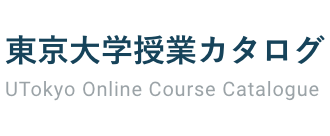学内のオンライン授業の情報漏洩防止のため,URLやアカウント、教室の記載は削除しております。
最終更新日:2025年4月21日
授業計画や教室は変更となる可能性があるため、必ずUTASで最新の情報を確認して下さい。
UTASにアクセスできない方は、担当教員または部局教務へお問い合わせ下さい。
最終更新日:2025年4月21日
授業計画や教室は変更となる可能性があるため、必ずUTASで最新の情報を確認して下さい。
UTASにアクセスできない方は、担当教員または部局教務へお問い合わせ下さい。
Economics of Contracts and Organizations
This course discusses topics on contract theory, with emphasis on incentive and agency problems, at a graduate level. The aim is to provide a basic ground of theoretical frameworks and to stimulate participants' research activities on contract theory and related issues.
The course is mainly for second-year graduate students or above. Other students or post-doctoral scholars interested in this course are also welcome as long as they satisfy the prerequisite described below.
時間割/共通科目コード
コース名
教員
学期
時限
291328-05
GEC-EC6835L2
Economics of Contracts and Organizations
石原 章史
月曜3限、月曜4限
経済思想史
「経済」とは何かという問題を、以下のような2点に注目して経済思想の歴史的展開から検討することを課題とする。第一に、「経済」という自律的秩序形成の領域がどのようにして認識されるようになってきたかということである。第二に、自律的秩序形成の領域として確立した後、その領域の「自立性」や「自律性」に対して如何に疑問が発せられてきたかである。
時間割/共通科目コード
コース名
教員
学期
時限
0704401
FEC-EH4801L1
経済思想史
石原 俊時
火曜3限、金曜3限
経済思想史
経済や社会がこれまでどのように論じられてきたかについて概説します。アダム・スミスやケインズといった経済学者の名前は,ほかの経済学の講義でも言及されますが,より詳細に,過去の著名な思想家の人物像や学説を紹介します。
時間割/共通科目コード
コース名
教員
学期
時限
31292
CAS-GC1A53L1
経済思想史
木村 雄一
火曜2限
Institutional Analysis of Japanese Economy II
We detail several factors that affected the fate of the Japanese economy from the eighteenth century to the twentieth century. Our first aim is to provide rich knowledge on the economic development of Japan. Japan’s historical experience has become more, not less, relevant to contemporary economists. For a long time, Japan had been the only non-Western industrialized economy. Now, led by China, the industrial power has dramatically shifted toward the non-Western world. Japan’s experience would give lessons to understand how a non-Western economy becomes industrialized and transforms own socio-economic system. Our second aim is to practice application of economics you have learned to a real case. The knowledge of economics enriches your intellectual and professional life only if you can adequately apply the theory you learned to the first-hand reality. We try it by taking examples from the Japanese experience.
時間割/共通科目コード
コース名
教員
学期
時限
291409
GEC-EC6409L3
Institutional Analysis of Japanese Economy II
中林 真幸
火曜3限
Institutional Analysis of Japanese Economy Ⅱ
We detail several factors that affected the fate of the Japanese economy from the eighteenth century to the twentieth century. Our first aim is to provide rich knowledge on the economic development of Japan. Japan’s historical experience has become more, not less, relevant to contemporary economists. For a long time, Japan had been the only non-Western industrialized economy. Now, led by China, the industrial power has dramatically shifted toward the non-Western world. Japan’s experience would give lessons to understand how a non-Western economy becomes industrialized and transforms own socio-economic system. Our second aim is to practice application of economics you have learned to a real case. The knowledge of economics enriches your intellectual and professional life only if you can adequately apply the theory you learned to the first-hand reality. We try it by taking examples from the Japanese experience.
時間割/共通科目コード
コース名
教員
学期
時限
0704453
FEC-EH5801L3
Institutional Analysis of Japanese Economy Ⅱ
中林 真幸
火曜3限
Institutional Analysis of Japanese Economy Ⅱ
We detail several factors that affected the fate of the Japanese economy from the eighteenth century to the twentieth century. Our first aim is to provide rich knowledge on the economic development of Japan. Japan’s historical experience has become more, not less, relevant to contemporary economists. For a long time, Japan had been the only non-Western industrialized economy. Now, led by China, the industrial power has dramatically shifted toward the non-Western world. Japan’s experience would give lessons to understand how a non-Western economy becomes industrialized and transforms own socio-economic system. Our second aim is to practice application of economics you have learned to a real case. The knowledge of economics enriches your intellectual and professional life only if you can adequately apply the theory you learned to the first-hand reality. We try it by taking examples from the Japanese experience.
時間割/共通科目コード
コース名
教員
学期
時限
5123238
GPP-MP6E20L3
Institutional Analysis of Japanese Economy Ⅱ
中林 真幸
火曜3限
Economic Analysis of Pandemics
You will learn analyses that were actually used as input to policy during the Covid-19 crisis in Japan. You will learn what happened during the Covid-19 crisis through research papers.
時間割/共通科目コード
コース名
教員
学期
時限
5123401
GPP-MP6E20L3
Economic Analysis of Pandemics
仲田 泰祐
月曜2限
経済学史
経済学史、思想史、知の歴史の分野での基礎的な研究方法を身につけること。
時間割/共通科目コード
コース名
教員
学期
時限
291109
GEC-EC6907S1
経済学史
野原 慎司
火曜2限
Institutional Analysis of Japanese Economy I
In the early seventh century, the imperial court completed introduction of the Chinese centralized administrative and land-ownership regime, which only proved to fail to provide appropriate incentives to relevant stake
holders. Adjustment of the regime to the reality brought about the manorial system.
The manorial system, the landownership and administrative system in medieval times, was a characterized by multiple claimants and stratified authorities on a parcel of farmland. This complicated mechanism better worked to share risk and to mitigate incentive problems that had become salient in the ancient times. Then, in early modern times, the shogunate and lords came to protect peasants' exclusive property right of a parcel farmland the peasant family cultivated, to provide augmented incentives to peasants who now became more resilient against external shocks. The protection of exclusive property right in the early modern times formed the institutional basis of the market economy. At the same time, the shogunate attempted to stabilize the peasant economy by regulating the
farmland and agricultural financial markets. The regulation enabled the social stability under the shogunate regime.
After the Meiji Restoration, the exclusive property right was reauthorized, and regulations on the farmland and financial markets were abandoned. Furthermore, modern judicial system and firm organizations, along with
modern technologies, were introduced from the West. The modernization effort accelerated market expansion and ignited industrialization.
Industrialization from the 1880s not only accelerated the productivity growth but also transformed the Japanese society to a more market oriented system, whose entire process is called industrial revolution. The modern sectors in the Japanese society composed a classical market economy from the 1880s to the 1910s. The development in the period was supported by the well integrated international market, and was at least partly accommodated by the pool of slack labor in the traditional sector. Since the 1920s, especially in the 1930s, those favorable environments were impaired. Without a stable international financial market, the macroeconomic stability of a national economy needed to be sustained by individual states. Such an international condition rather exacerbated difficulty of managing the society as the labor market was becoming tighter as slack labor in rural regions was absorbed by the growing modern sector. At the end, Japan chose a state-coordinated market economy after the experiment of command economy during the second world war.
Then, from the 1980s, the economy has gradually back to the normal, the rule-based market economy. As of the course is to overview institutional changes in the Japanese economy from the 1920s to the 2000s and to understand how institutional and organizational factors work in a changing society.
How was the manorial system formed, and how did it mitigate incentive problems then? How was property right of peasants was formed and protected in early modern times? Finally, how was Japan industrialized after the Meiji Restoration? In the real world, the first best resource allocation, which is presumed to be realized under perfect competition, cannot be achieved anyway. Given the structure of informational asymmetry and other technological conditions, a better second best has been sought and has evolved over times. The first aim of the course is to
understand economic development of Japan from the medieval times, through the Tokugawa period and the Meiji Restoration, to the industrial revolution in the late 19th century. Then, current shape of the Japanese economy would be better understood by placing the structural reform in the last three decades on a broader context from the 1920s. This is our goal.
時間割/共通科目コード
コース名
教員
学期
時限
291408
GEC-EC6408L3
Institutional Analysis of Japanese Economy I
中林 真幸
火曜3限
Institutional Analysis of Japanese Economy Ⅰ
In the early seventh century, the imperial court completed introduction of the Chinese centralized administrative and land-ownership regime, which only proved to fail to provide appropriate incentives to relevant stake
holders. Adjustment of the regime to the reality brought about the manorial system.
The manorial system, the landownership and administrative system in medieval times, was a characterized by multiple claimants and stratified authorities on a parcel of farmland. This complicated mechanism better worked to share risk and to mitigate incentive problems that had become salient in the ancient times. Then, in early modern times, the shogunate and lords came to protect peasants' exclusive property right of a parcel farmland the peasant family cultivated, to provide augmented incentives to peasants who now became more resilient against external shocks. The protection of exclusive property right in the early modern times formed the institutional basis of the market economy. At the same time, the shogunate attempted to stabilize the peasant economy by regulating the
farmland and agricultural financial markets. The regulation enabled the social stability under the shogunate regime.
After the Meiji Restoration, the exclusive property right was reauthorized, and regulations on the farmland and financial markets were abandoned. Furthermore, modern judicial system and firm organizations, along with
modern technologies, were introduced from the West. The modernization effort accelerated market expansion and ignited industrialization.
Industrialization from the 1880s not only accelerated the productivity growth but also transformed the Japanese society to a more market oriented system, whose entire process is called industrial revolution. The modern sectors in the Japanese society composed a classical market economy from the 1880s to the 1910s. The development in the period was supported by the well integrated international market, and was at least partly accommodated by the pool of slack labor in the traditional sector. Since the 1920s, especially in the 1930s, those favorable environments were impaired. Without a stable international financial market, the macroeconomic stability of a national economy needed to be sustained by individual states. Such an international condition rather exacerbated difficulty of managing the society as the labor market was becoming tighter as slack labor in rural regions was absorbed by the growing modern sector. At the end, Japan chose a state-coordinated market economy after the experiment of command economy during the second world war.
Then, from the 1980s, the economy has gradually back to the normal, the rule-based market economy. As of the course is to overview institutional changes in the Japanese economy from the 1920s to the 2000s and to understand how institutional and organizational factors work in a changing society.
How was the manorial system formed, and how did it mitigate incentive problems then? How was property right of peasants was formed and protected in early modern times? Finally, how was Japan industrialized after the Meiji Restoration? In the real world, the first best resource allocation, which is presumed to be realized under perfect competition, cannot be achieved anyway. Given the structure of informational asymmetry and other technological conditions, a better second best has been sought and has evolved over times. The first aim of the course is to
understand economic development of Japan from the medieval times, through the Tokugawa period and the Meiji Restoration, to the industrial revolution in the late 19th century. Then, current shape of the Japanese economy would be better understood by placing the structural reform in the last three decades on a broader context from the 1920s. This is our goal.
時間割/共通科目コード
コース名
教員
学期
時限
0704452
FEC-EH5801L3
Institutional Analysis of Japanese Economy Ⅰ
中林 真幸
火曜3限
1-10 / 全9738件









 マイリストに追加
マイリストに追加
 マイリストから削除
マイリストから削除


